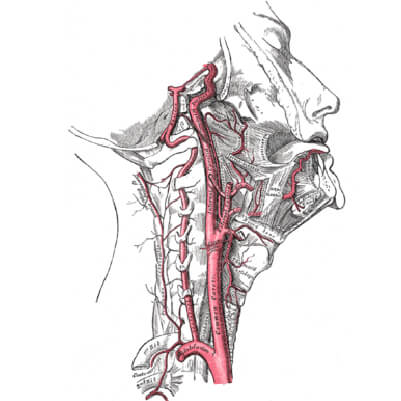CAROTID ARTERY DISEASES
The Carotid Arteries are major blood vessels in the neck that supply the brain with oxygen and nutrients. Carotid Artery Disease occurs when these arteries become narrowed or blocked by a buildup of plaque, a fatty substance made up of cholesterol, calcium, and other debris. This condition can lead to serious complications, such as stroke and transient ischemic attack (TIA), also known as a mini stroke.


Causes:
The exact cause of carotid artery disease is not known, but it is believed to be a result of atherosclerosis, a condition where plaque builds up in the arteries.
Symptoms:
In the early stages, carotid artery disease may not cause any noticeable symptoms. However, as the disease progresses, symptoms may include:
- Weakness or numbness in the face, arm, or leg, on one side of the body
- Slurred speech or difficulty speaking
- Vision problems in one or both eyes
- Dizziness or loss of balance
- Severe headache
Risk Factors:
Several factors increase the risk of developing carotid artery disease, including:
- Age: The risk of carotid artery disease increases as you get older.
- Smoking: Smoking damages the blood vessels and speeds up the formation of plaque.
- High blood pressure: High blood pressure increases the risk of plaque buildup in the arteries.
- High cholesterol: High levels of cholesterol contribute to the buildup of plaque in the arteries.
- Diabetes: People with diabetes are more likely to develop atherosclerosis and carotid artery disease.
- Family history: If a close family member has had heart disease, you are at a higher risk of developing carotid artery disease.
Diagnosis
Carotid artery disease can be diagnosed through various tests, including:
- Physician Exam: Physician may utilize a stethoscope to detect an unusual whooshing noise in your neck. This could potentially suggest the narrowing of one or more carotid arteries.
- Ultrasound: A non-invasive test that uses high-frequency sound waves to create images of the carotid arteries.
- Angiography: A test that uses a dye and X-rays to create images of the arteries.
- CT or MRI scan: These imaging tests can provide detailed images of the carotid arteries.
Treatment
At Messner Vascular Institute, we offer two procedures to treat carotid artery disease: carotid endarterectomy and carotid artery stenting or endovascular repair.
CAROTID ENDARTERECTOMY
Carotid endarterectomy is a surgical procedure used to remove the buildup of plaque from the carotid artery. During the procedure, the surgeon makes an incision in the neck and opens the carotid artery. The plaque is then removed, and the artery is repaired with a patch or stitch. This procedure is usually performed under general anesthesia and requires a hospital stay of a day or two.
CAROTID ARTERY STENTING OR ENDOVASCULAR REPAIR
Carotid artery stenting or endovascular repair is a minimally invasive procedure that involves the placement of a stent, a small metal mesh tube, in the carotid artery to open up the blockage and improve blood flow. During the procedure, a catheter is inserted into an artery in the groin and threaded up to the carotid artery. A small balloon is then inflated to open the artery, and the stent is placed to keep the artery open. This procedure is usually performed under local anesthesia and can often be done on an outpatient basis.
Both procedures have their own benefits and risks, and the decision on which procedure is best for you will depend on your individual condition and medical history. Our team of experienced vascular surgeons will work with you to determine the best course of treatment.
